Diabetes Mellitus: Program Planning, Design, and Evaluation
VerifiedAdded on 2023/06/03
|8
|2062
|81
Report
AI Summary
This report focuses on health promotion strategies for diabetes mellitus, emphasizing program planning, design, and evaluation. It begins with an introduction to the global increase in diabetes cases, differentiating between type 1 and type 2 diabetes and highlighting the importance of lifestyle modifications. The mission statement aims to reduce diabetes cases in the United States through interventions. The report outlines goals and objectives, including identifying diabetes triggers and methods for managing obesity. It then details various approaches and interventions, such as family involvement, promoting high-fiber foods, and leveraging health programs in schools and hospitals. The use of internet-based interventions and health promotion campaigns are also discussed. The report further explores program implementation through community-based interventions and addresses financial and theoretical aspects, specifically the Transtheoretical Model. The evaluation process is described, and the report concludes by highlighting the benefits of internet-based interventions, advocating for health promotion campaigns, and emphasizing the importance of individual behavior changes. References are provided for supporting research.
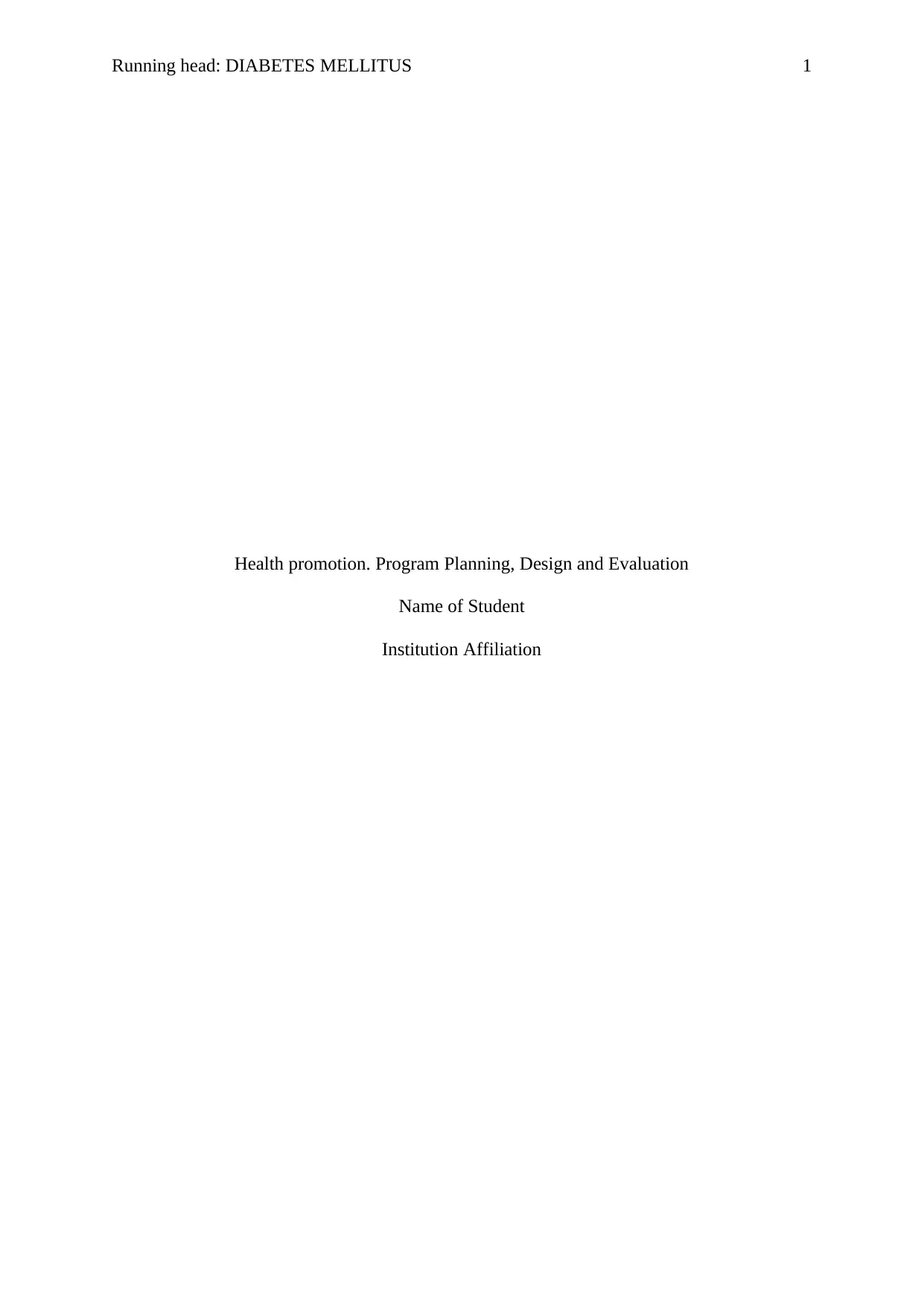
Running head: DIABETES MELLITUS 1
Health promotion. Program Planning, Design and Evaluation
Name of Student
Institution Affiliation
Health promotion. Program Planning, Design and Evaluation
Name of Student
Institution Affiliation
Paraphrase This Document
Need a fresh take? Get an instant paraphrase of this document with our AI Paraphraser
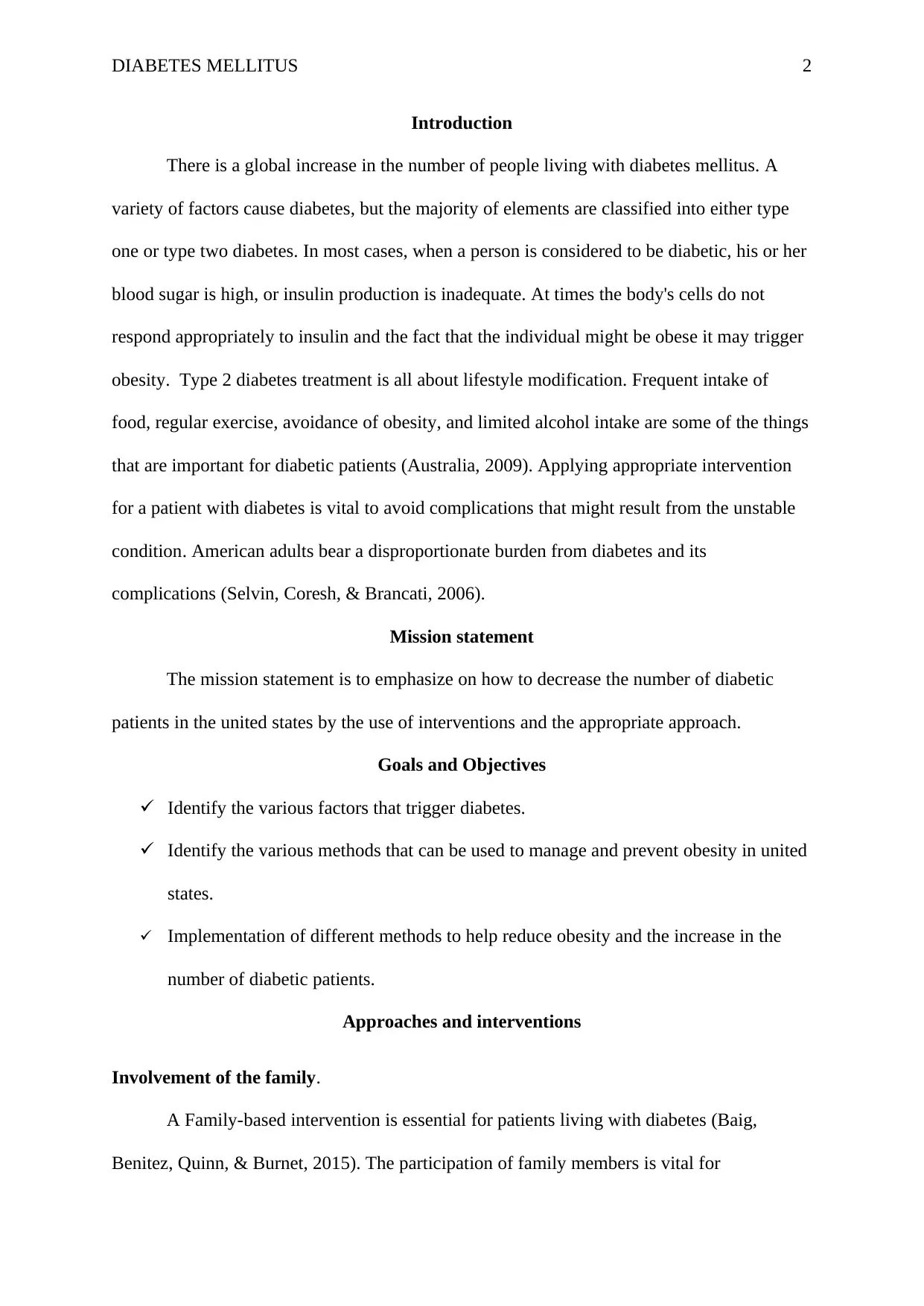
DIABETES MELLITUS 2
Introduction
There is a global increase in the number of people living with diabetes mellitus. A
variety of factors cause diabetes, but the majority of elements are classified into either type
one or type two diabetes. In most cases, when a person is considered to be diabetic, his or her
blood sugar is high, or insulin production is inadequate. At times the body's cells do not
respond appropriately to insulin and the fact that the individual might be obese it may trigger
obesity. Type 2 diabetes treatment is all about lifestyle modification. Frequent intake of
food, regular exercise, avoidance of obesity, and limited alcohol intake are some of the things
that are important for diabetic patients (Australia, 2009). Applying appropriate intervention
for a patient with diabetes is vital to avoid complications that might result from the unstable
condition. American adults bear a disproportionate burden from diabetes and its
complications (Selvin, Coresh, & Brancati, 2006).
Mission statement
The mission statement is to emphasize on how to decrease the number of diabetic
patients in the united states by the use of interventions and the appropriate approach.
Goals and Objectives
Identify the various factors that trigger diabetes.
Identify the various methods that can be used to manage and prevent obesity in united
states.
Implementation of different methods to help reduce obesity and the increase in the
number of diabetic patients.
Approaches and interventions
Involvement of the family.
A Family-based intervention is essential for patients living with diabetes (Baig,
Benitez, Quinn, & Burnet, 2015). The participation of family members is vital for
Introduction
There is a global increase in the number of people living with diabetes mellitus. A
variety of factors cause diabetes, but the majority of elements are classified into either type
one or type two diabetes. In most cases, when a person is considered to be diabetic, his or her
blood sugar is high, or insulin production is inadequate. At times the body's cells do not
respond appropriately to insulin and the fact that the individual might be obese it may trigger
obesity. Type 2 diabetes treatment is all about lifestyle modification. Frequent intake of
food, regular exercise, avoidance of obesity, and limited alcohol intake are some of the things
that are important for diabetic patients (Australia, 2009). Applying appropriate intervention
for a patient with diabetes is vital to avoid complications that might result from the unstable
condition. American adults bear a disproportionate burden from diabetes and its
complications (Selvin, Coresh, & Brancati, 2006).
Mission statement
The mission statement is to emphasize on how to decrease the number of diabetic
patients in the united states by the use of interventions and the appropriate approach.
Goals and Objectives
Identify the various factors that trigger diabetes.
Identify the various methods that can be used to manage and prevent obesity in united
states.
Implementation of different methods to help reduce obesity and the increase in the
number of diabetic patients.
Approaches and interventions
Involvement of the family.
A Family-based intervention is essential for patients living with diabetes (Baig,
Benitez, Quinn, & Burnet, 2015). The participation of family members is vital for
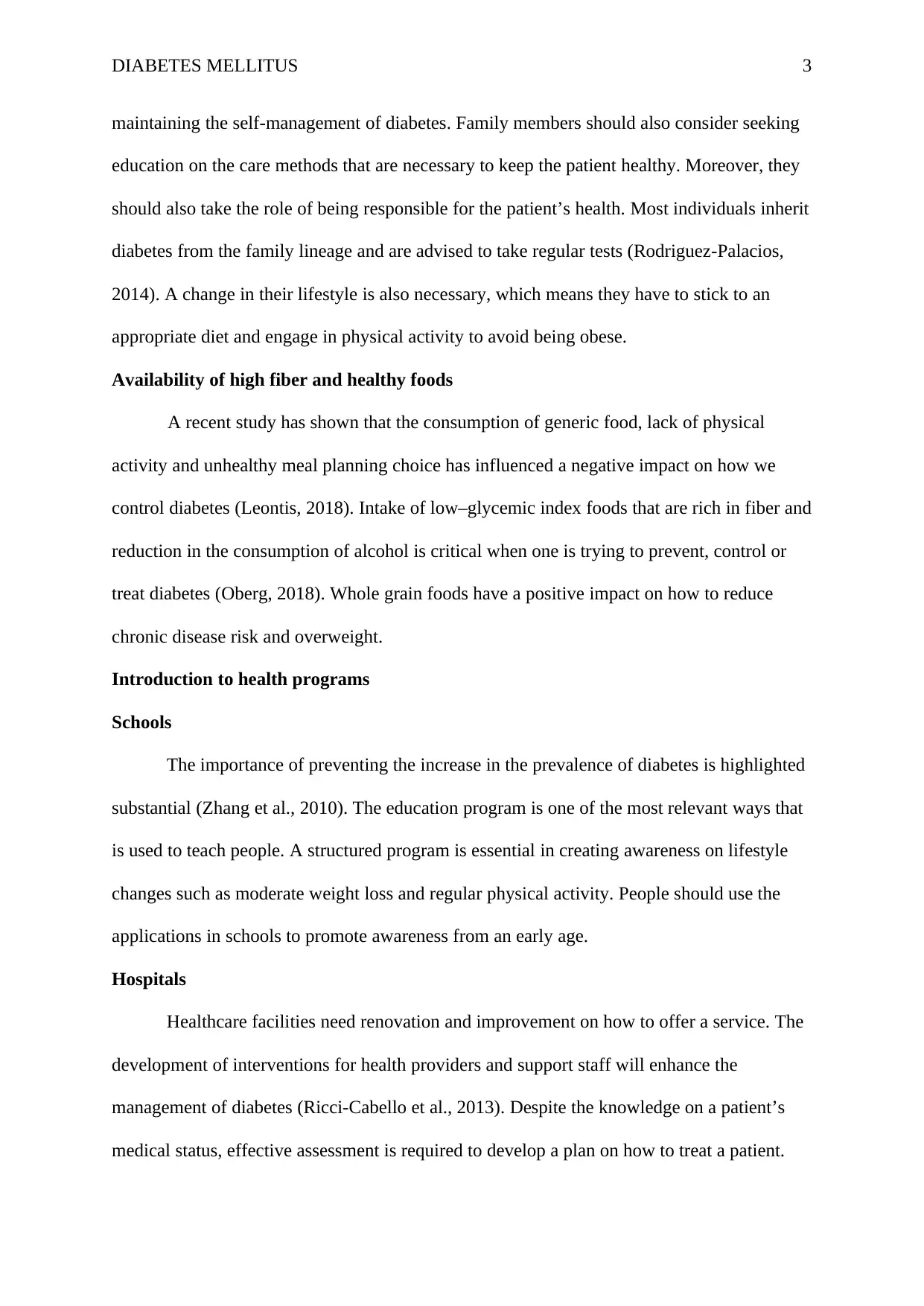
DIABETES MELLITUS 3
maintaining the self-management of diabetes. Family members should also consider seeking
education on the care methods that are necessary to keep the patient healthy. Moreover, they
should also take the role of being responsible for the patient’s health. Most individuals inherit
diabetes from the family lineage and are advised to take regular tests (Rodriguez-Palacios,
2014). A change in their lifestyle is also necessary, which means they have to stick to an
appropriate diet and engage in physical activity to avoid being obese.
Availability of high fiber and healthy foods
A recent study has shown that the consumption of generic food, lack of physical
activity and unhealthy meal planning choice has influenced a negative impact on how we
control diabetes (Leontis, 2018). Intake of low–glycemic index foods that are rich in fiber and
reduction in the consumption of alcohol is critical when one is trying to prevent, control or
treat diabetes (Oberg, 2018). Whole grain foods have a positive impact on how to reduce
chronic disease risk and overweight.
Introduction to health programs
Schools
The importance of preventing the increase in the prevalence of diabetes is highlighted
substantial (Zhang et al., 2010). The education program is one of the most relevant ways that
is used to teach people. A structured program is essential in creating awareness on lifestyle
changes such as moderate weight loss and regular physical activity. People should use the
applications in schools to promote awareness from an early age.
Hospitals
Healthcare facilities need renovation and improvement on how to offer a service. The
development of interventions for health providers and support staff will enhance the
management of diabetes (Ricci-Cabello et al., 2013). Despite the knowledge on a patient’s
medical status, effective assessment is required to develop a plan on how to treat a patient.
maintaining the self-management of diabetes. Family members should also consider seeking
education on the care methods that are necessary to keep the patient healthy. Moreover, they
should also take the role of being responsible for the patient’s health. Most individuals inherit
diabetes from the family lineage and are advised to take regular tests (Rodriguez-Palacios,
2014). A change in their lifestyle is also necessary, which means they have to stick to an
appropriate diet and engage in physical activity to avoid being obese.
Availability of high fiber and healthy foods
A recent study has shown that the consumption of generic food, lack of physical
activity and unhealthy meal planning choice has influenced a negative impact on how we
control diabetes (Leontis, 2018). Intake of low–glycemic index foods that are rich in fiber and
reduction in the consumption of alcohol is critical when one is trying to prevent, control or
treat diabetes (Oberg, 2018). Whole grain foods have a positive impact on how to reduce
chronic disease risk and overweight.
Introduction to health programs
Schools
The importance of preventing the increase in the prevalence of diabetes is highlighted
substantial (Zhang et al., 2010). The education program is one of the most relevant ways that
is used to teach people. A structured program is essential in creating awareness on lifestyle
changes such as moderate weight loss and regular physical activity. People should use the
applications in schools to promote awareness from an early age.
Hospitals
Healthcare facilities need renovation and improvement on how to offer a service. The
development of interventions for health providers and support staff will enhance the
management of diabetes (Ricci-Cabello et al., 2013). Despite the knowledge on a patient’s
medical status, effective assessment is required to develop a plan on how to treat a patient.
⊘ This is a preview!⊘
Do you want full access?
Subscribe today to unlock all pages.

Trusted by 1+ million students worldwide
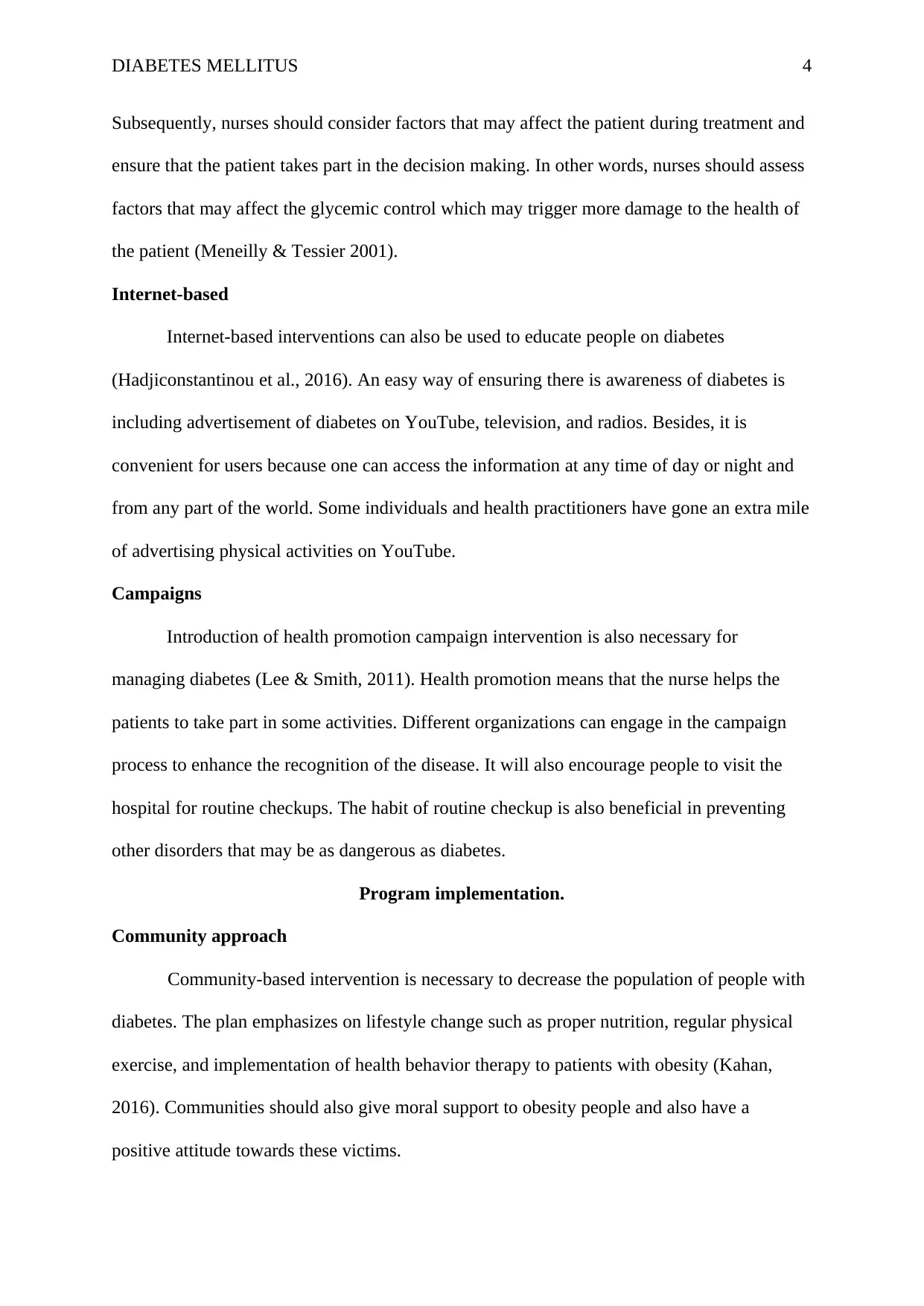
DIABETES MELLITUS 4
Subsequently, nurses should consider factors that may affect the patient during treatment and
ensure that the patient takes part in the decision making. In other words, nurses should assess
factors that may affect the glycemic control which may trigger more damage to the health of
the patient (Meneilly & Tessier 2001).
Internet-based
Internet-based interventions can also be used to educate people on diabetes
(Hadjiconstantinou et al., 2016). An easy way of ensuring there is awareness of diabetes is
including advertisement of diabetes on YouTube, television, and radios. Besides, it is
convenient for users because one can access the information at any time of day or night and
from any part of the world. Some individuals and health practitioners have gone an extra mile
of advertising physical activities on YouTube.
Campaigns
Introduction of health promotion campaign intervention is also necessary for
managing diabetes (Lee & Smith, 2011). Health promotion means that the nurse helps the
patients to take part in some activities. Different organizations can engage in the campaign
process to enhance the recognition of the disease. It will also encourage people to visit the
hospital for routine checkups. The habit of routine checkup is also beneficial in preventing
other disorders that may be as dangerous as diabetes.
Program implementation.
Community approach
Community-based intervention is necessary to decrease the population of people with
diabetes. The plan emphasizes on lifestyle change such as proper nutrition, regular physical
exercise, and implementation of health behavior therapy to patients with obesity (Kahan,
2016). Communities should also give moral support to obesity people and also have a
positive attitude towards these victims.
Subsequently, nurses should consider factors that may affect the patient during treatment and
ensure that the patient takes part in the decision making. In other words, nurses should assess
factors that may affect the glycemic control which may trigger more damage to the health of
the patient (Meneilly & Tessier 2001).
Internet-based
Internet-based interventions can also be used to educate people on diabetes
(Hadjiconstantinou et al., 2016). An easy way of ensuring there is awareness of diabetes is
including advertisement of diabetes on YouTube, television, and radios. Besides, it is
convenient for users because one can access the information at any time of day or night and
from any part of the world. Some individuals and health practitioners have gone an extra mile
of advertising physical activities on YouTube.
Campaigns
Introduction of health promotion campaign intervention is also necessary for
managing diabetes (Lee & Smith, 2011). Health promotion means that the nurse helps the
patients to take part in some activities. Different organizations can engage in the campaign
process to enhance the recognition of the disease. It will also encourage people to visit the
hospital for routine checkups. The habit of routine checkup is also beneficial in preventing
other disorders that may be as dangerous as diabetes.
Program implementation.
Community approach
Community-based intervention is necessary to decrease the population of people with
diabetes. The plan emphasizes on lifestyle change such as proper nutrition, regular physical
exercise, and implementation of health behavior therapy to patients with obesity (Kahan,
2016). Communities should also give moral support to obesity people and also have a
positive attitude towards these victims.
Paraphrase This Document
Need a fresh take? Get an instant paraphrase of this document with our AI Paraphraser
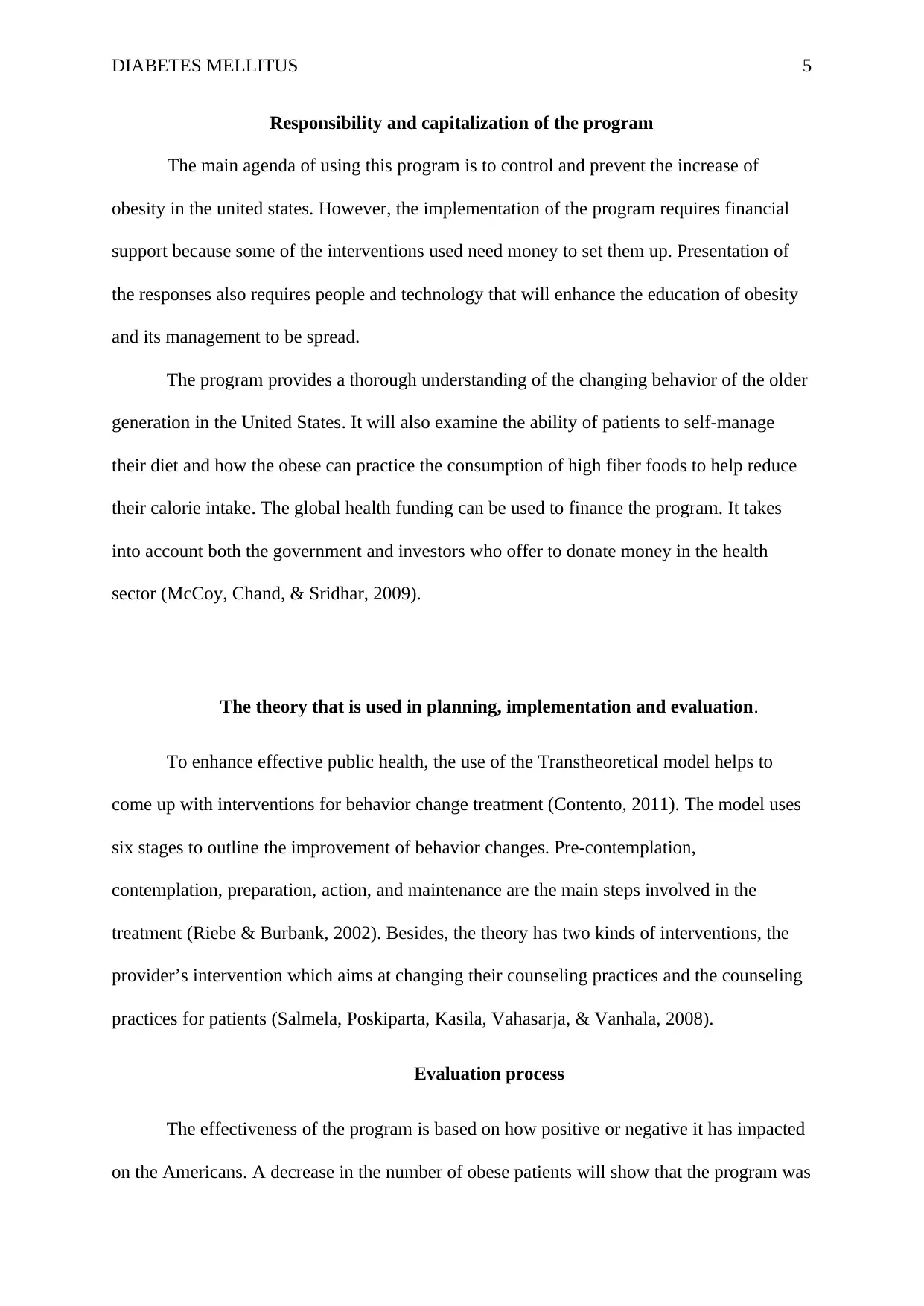
DIABETES MELLITUS 5
Responsibility and capitalization of the program
The main agenda of using this program is to control and prevent the increase of
obesity in the united states. However, the implementation of the program requires financial
support because some of the interventions used need money to set them up. Presentation of
the responses also requires people and technology that will enhance the education of obesity
and its management to be spread.
The program provides a thorough understanding of the changing behavior of the older
generation in the United States. It will also examine the ability of patients to self-manage
their diet and how the obese can practice the consumption of high fiber foods to help reduce
their calorie intake. The global health funding can be used to finance the program. It takes
into account both the government and investors who offer to donate money in the health
sector (McCoy, Chand, & Sridhar, 2009).
The theory that is used in planning, implementation and evaluation.
To enhance effective public health, the use of the Transtheoretical model helps to
come up with interventions for behavior change treatment (Contento, 2011). The model uses
six stages to outline the improvement of behavior changes. Pre-contemplation,
contemplation, preparation, action, and maintenance are the main steps involved in the
treatment (Riebe & Burbank, 2002). Besides, the theory has two kinds of interventions, the
provider’s intervention which aims at changing their counseling practices and the counseling
practices for patients (Salmela, Poskiparta, Kasila, Vahasarja, & Vanhala, 2008).
Evaluation process
The effectiveness of the program is based on how positive or negative it has impacted
on the Americans. A decrease in the number of obese patients will show that the program was
Responsibility and capitalization of the program
The main agenda of using this program is to control and prevent the increase of
obesity in the united states. However, the implementation of the program requires financial
support because some of the interventions used need money to set them up. Presentation of
the responses also requires people and technology that will enhance the education of obesity
and its management to be spread.
The program provides a thorough understanding of the changing behavior of the older
generation in the United States. It will also examine the ability of patients to self-manage
their diet and how the obese can practice the consumption of high fiber foods to help reduce
their calorie intake. The global health funding can be used to finance the program. It takes
into account both the government and investors who offer to donate money in the health
sector (McCoy, Chand, & Sridhar, 2009).
The theory that is used in planning, implementation and evaluation.
To enhance effective public health, the use of the Transtheoretical model helps to
come up with interventions for behavior change treatment (Contento, 2011). The model uses
six stages to outline the improvement of behavior changes. Pre-contemplation,
contemplation, preparation, action, and maintenance are the main steps involved in the
treatment (Riebe & Burbank, 2002). Besides, the theory has two kinds of interventions, the
provider’s intervention which aims at changing their counseling practices and the counseling
practices for patients (Salmela, Poskiparta, Kasila, Vahasarja, & Vanhala, 2008).
Evaluation process
The effectiveness of the program is based on how positive or negative it has impacted
on the Americans. A decrease in the number of obese patients will show that the program was
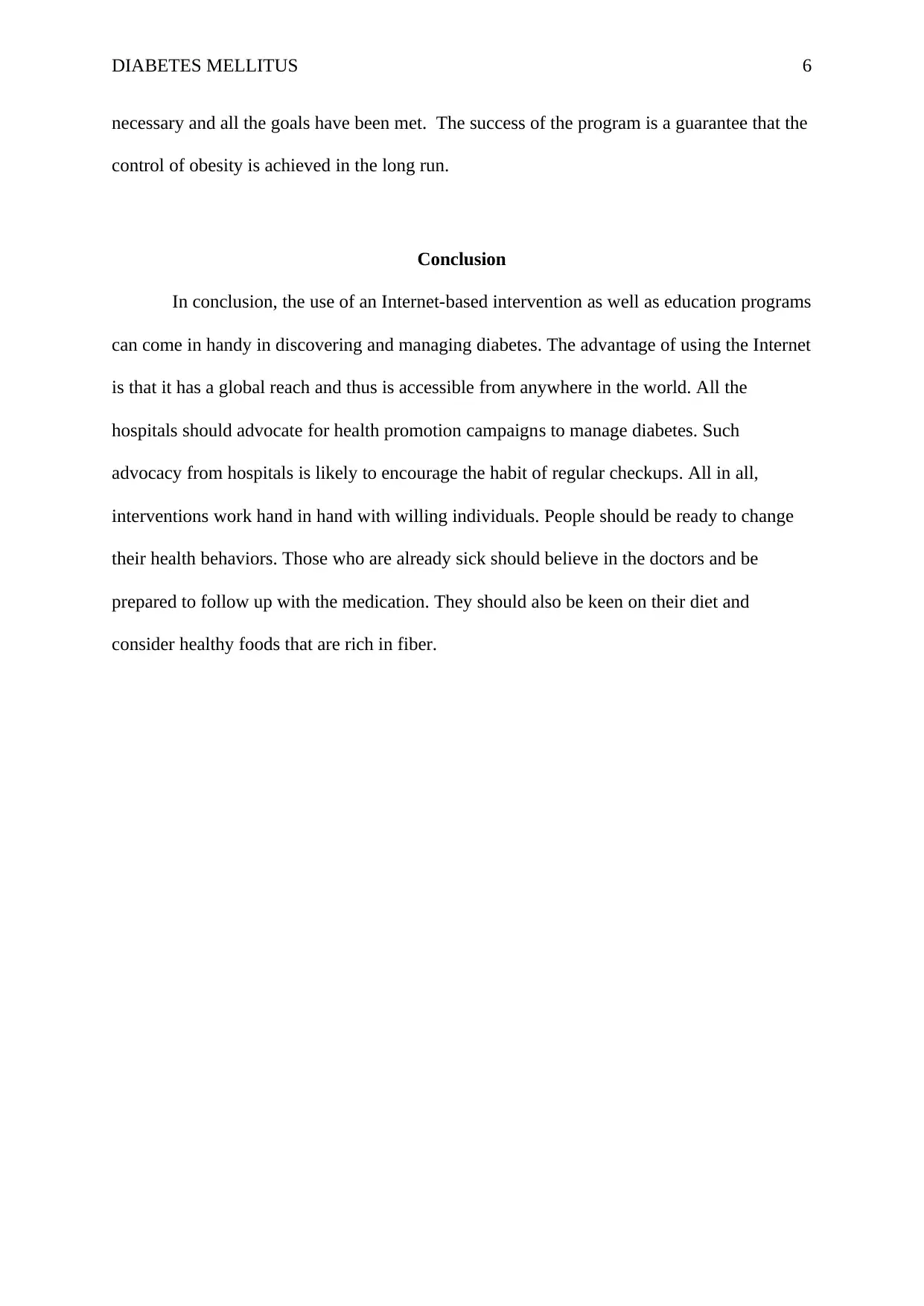
DIABETES MELLITUS 6
necessary and all the goals have been met. The success of the program is a guarantee that the
control of obesity is achieved in the long run.
Conclusion
In conclusion, the use of an Internet-based intervention as well as education programs
can come in handy in discovering and managing diabetes. The advantage of using the Internet
is that it has a global reach and thus is accessible from anywhere in the world. All the
hospitals should advocate for health promotion campaigns to manage diabetes. Such
advocacy from hospitals is likely to encourage the habit of regular checkups. All in all,
interventions work hand in hand with willing individuals. People should be ready to change
their health behaviors. Those who are already sick should believe in the doctors and be
prepared to follow up with the medication. They should also be keen on their diet and
consider healthy foods that are rich in fiber.
necessary and all the goals have been met. The success of the program is a guarantee that the
control of obesity is achieved in the long run.
Conclusion
In conclusion, the use of an Internet-based intervention as well as education programs
can come in handy in discovering and managing diabetes. The advantage of using the Internet
is that it has a global reach and thus is accessible from anywhere in the world. All the
hospitals should advocate for health promotion campaigns to manage diabetes. Such
advocacy from hospitals is likely to encourage the habit of regular checkups. All in all,
interventions work hand in hand with willing individuals. People should be ready to change
their health behaviors. Those who are already sick should believe in the doctors and be
prepared to follow up with the medication. They should also be keen on their diet and
consider healthy foods that are rich in fiber.
⊘ This is a preview!⊘
Do you want full access?
Subscribe today to unlock all pages.

Trusted by 1+ million students worldwide
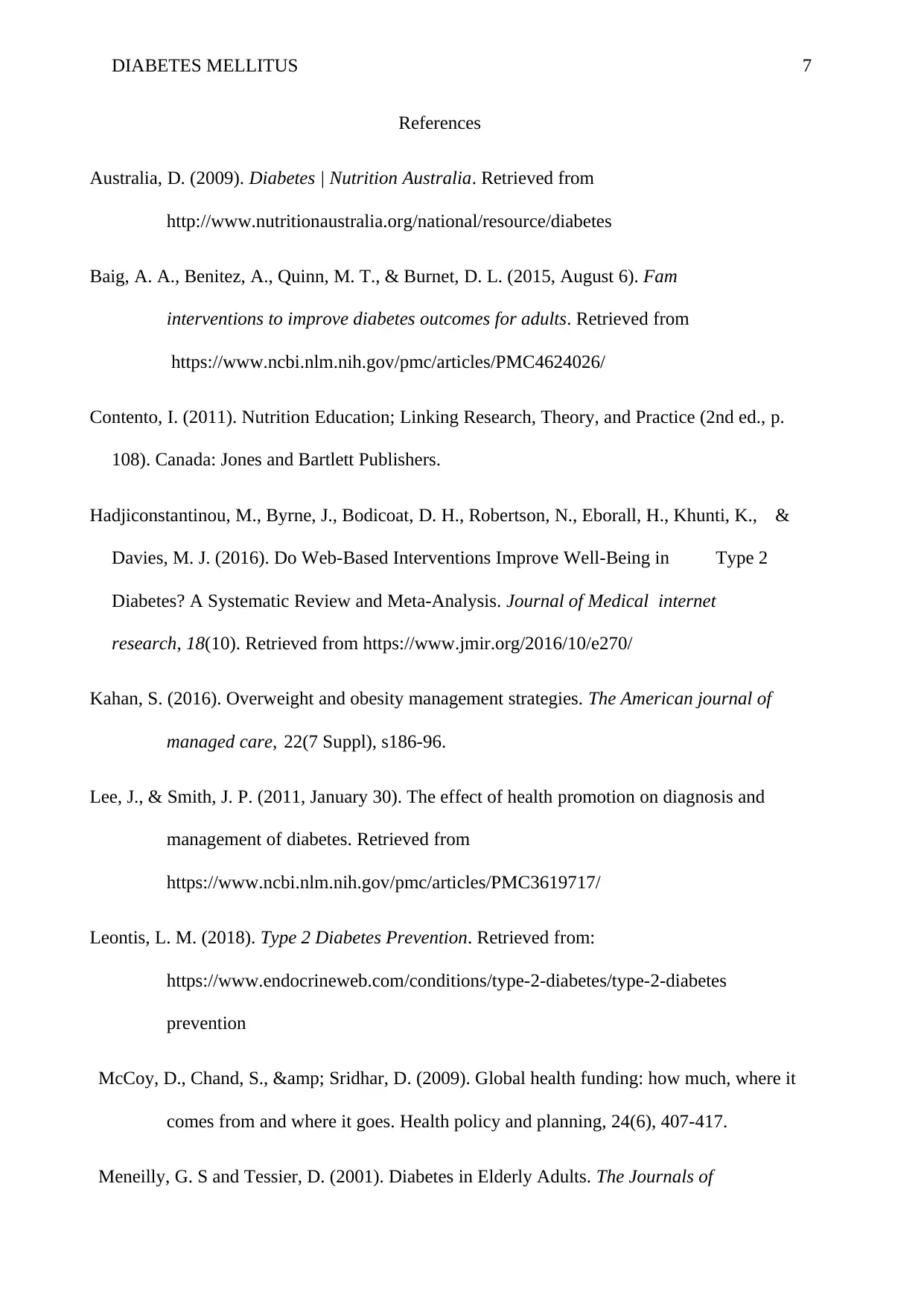
DIABETES MELLITUS 7
References
Australia, D. (2009). Diabetes | Nutrition Australia. Retrieved from
http://www.nutritionaustralia.org/national/resource/diabetes
Baig, A. A., Benitez, A., Quinn, M. T., & Burnet, D. L. (2015, August 6). Fam
interventions to improve diabetes outcomes for adults. Retrieved from
https://www.ncbi.nlm.nih.gov/pmc/articles/PMC4624026/
Contento, I. (2011). Nutrition Education; Linking Research, Theory, and Practice (2nd ed., p.
108). Canada: Jones and Bartlett Publishers.
Hadjiconstantinou, M., Byrne, J., Bodicoat, D. H., Robertson, N., Eborall, H., Khunti, K., &
Davies, M. J. (2016). Do Web-Based Interventions Improve Well-Being in Type 2
Diabetes? A Systematic Review and Meta-Analysis. Journal of Medical internet
research, 18(10). Retrieved from https://www.jmir.org/2016/10/e270/
Kahan, S. (2016). Overweight and obesity management strategies. The American journal of
managed care, 22(7 Suppl), s186-96.
Lee, J., & Smith, J. P. (2011, January 30). The effect of health promotion on diagnosis and
management of diabetes. Retrieved from
https://www.ncbi.nlm.nih.gov/pmc/articles/PMC3619717/
Leontis, L. M. (2018). Type 2 Diabetes Prevention. Retrieved from:
https://www.endocrineweb.com/conditions/type-2-diabetes/type-2-diabetes
prevention
McCoy, D., Chand, S., & Sridhar, D. (2009). Global health funding: how much, where it
comes from and where it goes. Health policy and planning, 24(6), 407-417.
Meneilly, G. S and Tessier, D. (2001). Diabetes in Elderly Adults. The Journals of
References
Australia, D. (2009). Diabetes | Nutrition Australia. Retrieved from
http://www.nutritionaustralia.org/national/resource/diabetes
Baig, A. A., Benitez, A., Quinn, M. T., & Burnet, D. L. (2015, August 6). Fam
interventions to improve diabetes outcomes for adults. Retrieved from
https://www.ncbi.nlm.nih.gov/pmc/articles/PMC4624026/
Contento, I. (2011). Nutrition Education; Linking Research, Theory, and Practice (2nd ed., p.
108). Canada: Jones and Bartlett Publishers.
Hadjiconstantinou, M., Byrne, J., Bodicoat, D. H., Robertson, N., Eborall, H., Khunti, K., &
Davies, M. J. (2016). Do Web-Based Interventions Improve Well-Being in Type 2
Diabetes? A Systematic Review and Meta-Analysis. Journal of Medical internet
research, 18(10). Retrieved from https://www.jmir.org/2016/10/e270/
Kahan, S. (2016). Overweight and obesity management strategies. The American journal of
managed care, 22(7 Suppl), s186-96.
Lee, J., & Smith, J. P. (2011, January 30). The effect of health promotion on diagnosis and
management of diabetes. Retrieved from
https://www.ncbi.nlm.nih.gov/pmc/articles/PMC3619717/
Leontis, L. M. (2018). Type 2 Diabetes Prevention. Retrieved from:
https://www.endocrineweb.com/conditions/type-2-diabetes/type-2-diabetes
prevention
McCoy, D., Chand, S., & Sridhar, D. (2009). Global health funding: how much, where it
comes from and where it goes. Health policy and planning, 24(6), 407-417.
Meneilly, G. S and Tessier, D. (2001). Diabetes in Elderly Adults. The Journals of
Paraphrase This Document
Need a fresh take? Get an instant paraphrase of this document with our AI Paraphraser
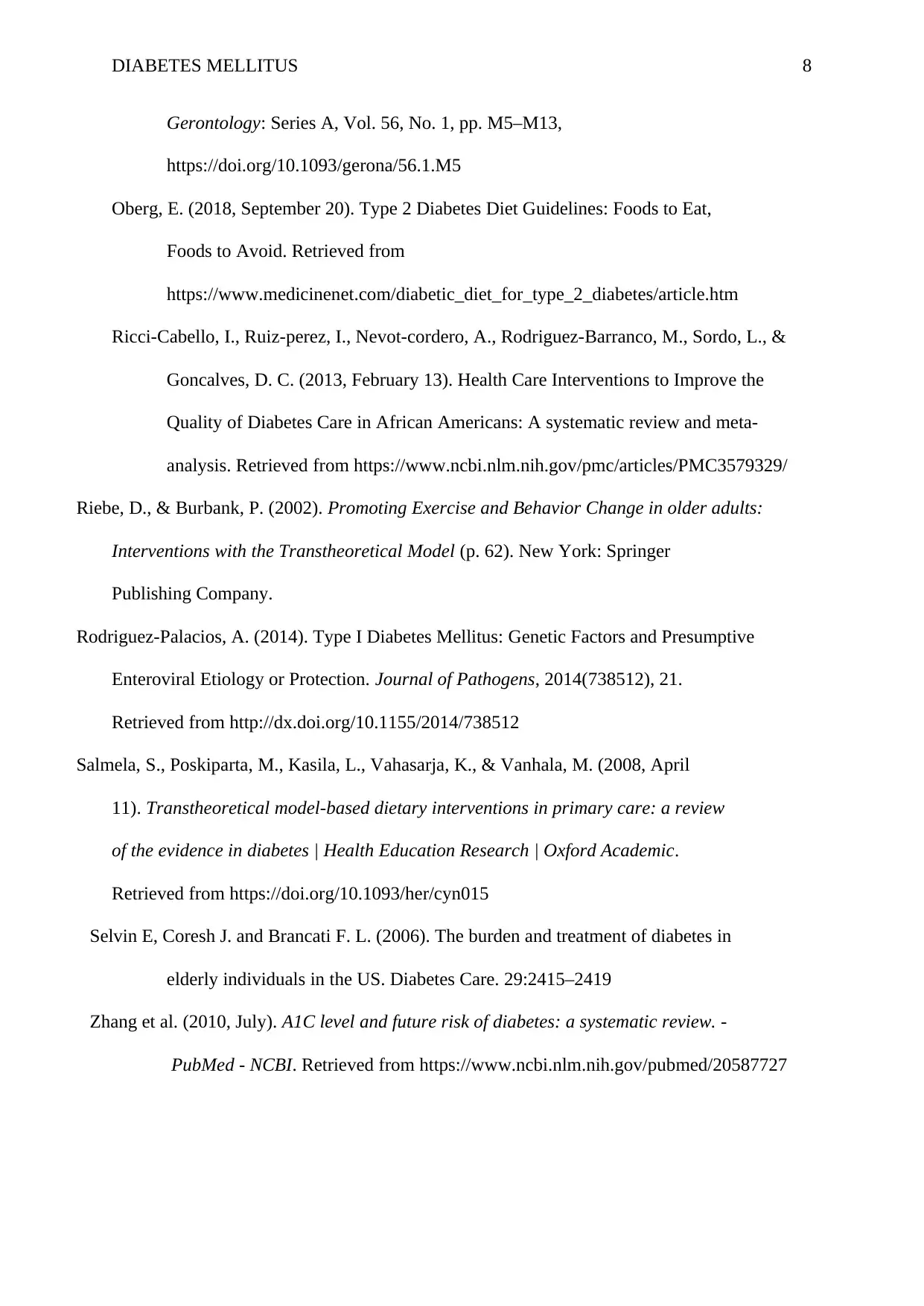
DIABETES MELLITUS 8
Gerontology: Series A, Vol. 56, No. 1, pp. M5–M13,
https://doi.org/10.1093/gerona/56.1.M5
Oberg, E. (2018, September 20). Type 2 Diabetes Diet Guidelines: Foods to Eat,
Foods to Avoid. Retrieved from
https://www.medicinenet.com/diabetic_diet_for_type_2_diabetes/article.htm
Ricci-Cabello, I., Ruiz-perez, I., Nevot-cordero, A., Rodriguez-Barranco, M., Sordo, L., &
Goncalves, D. C. (2013, February 13). Health Care Interventions to Improve the
Quality of Diabetes Care in African Americans: A systematic review and meta-
analysis. Retrieved from https://www.ncbi.nlm.nih.gov/pmc/articles/PMC3579329/
Riebe, D., & Burbank, P. (2002). Promoting Exercise and Behavior Change in older adults:
Interventions with the Transtheoretical Model (p. 62). New York: Springer
Publishing Company.
Rodriguez-Palacios, A. (2014). Type I Diabetes Mellitus: Genetic Factors and Presumptive
Enteroviral Etiology or Protection. Journal of Pathogens, 2014(738512), 21.
Retrieved from http://dx.doi.org/10.1155/2014/738512
Salmela, S., Poskiparta, M., Kasila, L., Vahasarja, K., & Vanhala, M. (2008, April
11). Transtheoretical model-based dietary interventions in primary care: a review
of the evidence in diabetes | Health Education Research | Oxford Academic.
Retrieved from https://doi.org/10.1093/her/cyn015
Selvin E, Coresh J. and Brancati F. L. (2006). The burden and treatment of diabetes in
elderly individuals in the US. Diabetes Care. 29:2415–2419
Zhang et al. (2010, July). A1C level and future risk of diabetes: a systematic review. -
PubMed - NCBI. Retrieved from https://www.ncbi.nlm.nih.gov/pubmed/20587727
Gerontology: Series A, Vol. 56, No. 1, pp. M5–M13,
https://doi.org/10.1093/gerona/56.1.M5
Oberg, E. (2018, September 20). Type 2 Diabetes Diet Guidelines: Foods to Eat,
Foods to Avoid. Retrieved from
https://www.medicinenet.com/diabetic_diet_for_type_2_diabetes/article.htm
Ricci-Cabello, I., Ruiz-perez, I., Nevot-cordero, A., Rodriguez-Barranco, M., Sordo, L., &
Goncalves, D. C. (2013, February 13). Health Care Interventions to Improve the
Quality of Diabetes Care in African Americans: A systematic review and meta-
analysis. Retrieved from https://www.ncbi.nlm.nih.gov/pmc/articles/PMC3579329/
Riebe, D., & Burbank, P. (2002). Promoting Exercise and Behavior Change in older adults:
Interventions with the Transtheoretical Model (p. 62). New York: Springer
Publishing Company.
Rodriguez-Palacios, A. (2014). Type I Diabetes Mellitus: Genetic Factors and Presumptive
Enteroviral Etiology or Protection. Journal of Pathogens, 2014(738512), 21.
Retrieved from http://dx.doi.org/10.1155/2014/738512
Salmela, S., Poskiparta, M., Kasila, L., Vahasarja, K., & Vanhala, M. (2008, April
11). Transtheoretical model-based dietary interventions in primary care: a review
of the evidence in diabetes | Health Education Research | Oxford Academic.
Retrieved from https://doi.org/10.1093/her/cyn015
Selvin E, Coresh J. and Brancati F. L. (2006). The burden and treatment of diabetes in
elderly individuals in the US. Diabetes Care. 29:2415–2419
Zhang et al. (2010, July). A1C level and future risk of diabetes: a systematic review. -
PubMed - NCBI. Retrieved from https://www.ncbi.nlm.nih.gov/pubmed/20587727
1 out of 8
Related Documents
Your All-in-One AI-Powered Toolkit for Academic Success.
+13062052269
info@desklib.com
Available 24*7 on WhatsApp / Email
![[object Object]](/_next/static/media/star-bottom.7253800d.svg)
Unlock your academic potential
Copyright © 2020–2025 A2Z Services. All Rights Reserved. Developed and managed by ZUCOL.





